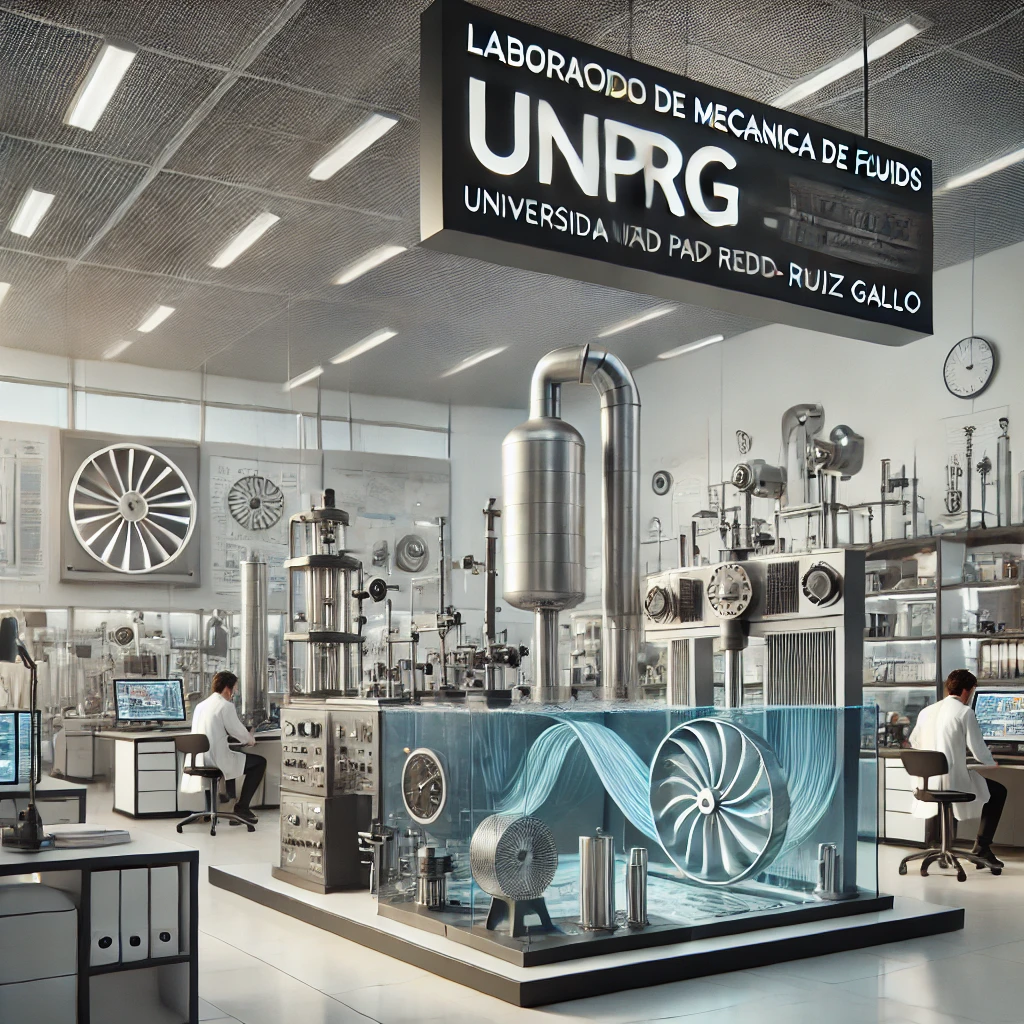UNPRG – Laboratorio de Mecánica de Fluidos
Introduction
The Laboratorio de Mecánica de Fluidos at the Universidad Nacional Pedro Ruiz Gallo (UNPRG) in Peru is a cornerstone of academic, research, and industrial applications in fluid mechanics. Fluid mechanics, a critical area of engineering science, studies the behavior of fluids (liquids and gases) in motion and at rest. The laboratory’s contributions span from academic support for students to solving real-world challenges in energy, transportation, and environmental sustainability.
This article delves into the laboratory’s mission, infrastructure, methodologies, research initiatives, educational integration, and its role in addressing global engineering challenges.
The Significance of Fluid Mechanics
Fluid mechanics underpins various natural and engineered systems, including weather patterns, ocean currents, pipelines, and aerodynamic systems. Understanding fluid behavior is crucial for advancements in renewable energy, climate modeling, infrastructure development, and industrial optimization. The Laboratorio de Mecánica de Fluidos (LMF) provides a platform where theoretical knowledge and practical experimentation converge, fostering innovation and skill development.
Mission and Vision of the Laboratory
The LMF’s mission is threefold:
- Education: To enhance the academic journey of students by providing practical experience in fluid mechanics principles.
- Research: To push the boundaries of knowledge in fluid mechanics through innovative and interdisciplinary research.
- Industry Collaboration: To offer solutions to industrial challenges, promoting efficiency and sustainability in fluid systems.
Its vision is to become a leading center for fluid mechanics in Latin America, renowned for its research contributions and industrial partnerships.
Infrastructure and Resources
The LMF is equipped with state-of-the-art facilities, enabling a wide range of experimental and computational studies. These resources include:
Experimental Equipment
- Wind Tunnels:
- Used to study aerodynamic properties of structures, vehicles, and wind turbines.
- Supports research in drag reduction and efficiency optimization.
- Hydraulic Benches:
- Aid in analyzing fluid flow through pipes and open channels.
- Demonstrates principles like continuity, Bernoulli’s theorem, and energy loss.
- Flow Measurement Devices:
- Includes orifice meters, Venturi meters, and rotameters to measure flow rates and pressure drops.
- Visualization Tools:
- Dye injection systems and high-speed cameras for studying flow patterns and turbulence.
Computational Resources
- CFD Software:
- Software like ANSYS Fluent and OpenFOAM for simulating complex fluid interactions.
- Helps in solving large-scale problems that are impractical to replicate experimentally.
- High-Performance Computing (HPC):
- Ensures faster simulations and precise modeling.
Laboratories and Workshops
Dedicated spaces for:
- Material preparation and prototype development.
- Data analysis and result visualization.
Methodologies and Techniques
The LMF employs a blend of experimental and numerical approaches to address diverse challenges.
Experimental Techniques
- Velocity and Pressure Measurements:
- Use of Pitot tubes, manometers, and digital sensors to quantify fluid properties.
- Turbulence Studies:
- Analysis of turbulent flow regimes to optimize engineering designs.
- Boundary Layer Analysis:
- Understanding the interaction of fluids with surfaces to improve aerodynamic and hydrodynamic performance.
Numerical Simulations

- CFD Modeling:
- Simulation of complex phenomena such as vortex shedding, multiphase flows, and heat transfer.
- Optimization Studies:
- Identifying the best configurations for fluid systems through parameter variation.
Hybrid Approaches
Combining experimental data with numerical simulations ensures validation and enhances predictive accuracy.
Educational Integration
The LMF is integral to the academic framework of UNPRG, offering:
- Practical Learning:
- Hands-on experiments complement classroom teaching.
- Students gain insights into real-world applications of fluid mechanics principles.
- Project Development:
- Support for undergraduate and graduate theses on topics like renewable energy systems, water resource management, and fluid-structure interaction.
- Workshops and Seminars:
- Regular events to train students in using cutting-edge tools and techniques.
- Competitions:
- Participation in national and international challenges fosters creativity and innovation.
Research Focus Areas
The laboratory’s research spans a wide spectrum of topics, addressing both fundamental and applied problems.
Aerodynamics
- Vehicle Design:
- Studying airflow around automobiles to reduce drag and enhance fuel efficiency.
- Aviation:
- Optimizing wing profiles for better lift-to-drag ratios.
Hydrodynamics

- Water Resource Management:
- Modeling flows in rivers, reservoirs, and irrigation systems.
- Marine Applications:
- Studying wave interactions with ships and offshore structures.
Environmental Fluid Mechanics
- Pollution Control:
- Simulating the dispersion of pollutants in air and water.
- Flood Management:
- Designing systems to predict and mitigate flood impacts.
Multiphase Flows
- Industrial Applications:
- Investigating flows involving gas-liquid or liquid-solid phases in pipelines.
- Energy Systems:
- Optimizing the performance of fuel injectors and hydraulic turbines.
Renewable Energy
- Wind Energy:
- Enhancing wind turbine efficiency by studying wake effects and blade design.
- Hydroelectric Power:
- Improving turbine designs for better energy conversion.
Societal and Industrial Impact
The LMF actively collaborates with industries and governmental organizations to address societal challenges.
Industrial Contributions
- Pipeline Optimization:
- Developing efficient transport systems for oil, gas, and water.
- HVAC Systems:
- Enhancing the energy efficiency of heating, ventilation, and air conditioning systems.
Environmental Solutions
- Sustainable Water Systems:
- Designing eco-friendly irrigation and drainage solutions.
- Climate Adaptation:
- Creating models to predict and respond to extreme weather events.
Innovation in Energy
- Wind Farms:
- Optimizing layouts to minimize wake interference and maximize power output.
- Small Hydropower Projects:
- Enabling rural electrification through cost-effective solutions.
Challenges and Opportunities
Current Challenges
- Resource Constraints:
- Upgrading equipment and maintaining facilities require significant investment.
- Interdisciplinary Gaps:
- Bridging the gap between fluid mechanics and fields like biology and materials science.
Opportunities
- Emerging Technologies:
- Integrating AI and machine learning to enhance simulation accuracy and experimental design.
- Global Collaboration:
- Partnering with international research institutes to tackle global challenges.
- Sustainability Focus:
- Prioritizing renewable energy and eco-friendly designs.
Future Directions
The LMF aims to:
- Expand Capabilities:
- Acquire advanced equipment like particle image velocimetry (PIV) systems.
- Enhance Outreach:
- Conduct public awareness programs on water conservation and energy efficiency.
- Strengthen Research:
- Focus on cutting-edge topics like bio-inspired fluid mechanics and nanofluid applications.
Conclusion
The Laboratorio de Mecánica de Fluidos at UNPRG exemplifies the integration of education, research, and real-world applications in fluid mechanics. By fostering innovation, supporting academic growth, and addressing industrial and societal challenges, the laboratory remains a vital contributor to scientific and technological progress.







Post Comment